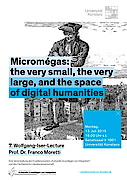Micromégas: the very small, the very large, and the space of digital humanities
13. July 2015
Wolfgang Iser Lecture 2015
Prof. Franco Moretti (Stanford)
A process whereby many very small units add up to a single very large system has become typical of the digital humanities — the signature, almost, of their approach to literature. It has also dramatically brought to light the role of scale in literary study: dramatically, in the sense that DH seem irresistibly drawn towards the extremes of the scale, whereas literary study has traditionally focused on the middle of the scale.
The middle as “the text”, usually; or as a scene, an excerpt, a series of verses to be memorized, quotations, allusions… Many choices, but all linked to this scale in the middle; probably, because it agrees so well with our capacity to understand, remember, and judge. This scale where readers are truly “the measure of things” seems so “natural” that it‘s never even perceived as a scale: it seems to go without saying. DH has shattered this long-standing convention. So, what does it mean, studying literature through these new coordinates – what does “literature” itself become, among charts and diagrams? This is the question I will try to address.
Franco Moretti is Danily C. and Laura Louise Bell Professor in the Humanities at Stanford University.
In 2000, he introduced the widely discussed method called distant reading into the Humanities, which means the computer analysis of thousands of pieces of literature. On the contrary, close reading is the careful, sustained interpretation of a brief passage of text.
His latest books are The Bourgeois (2013), and Distant Reading (2013).
Mon, 13 July 2015, 7pm
University of Konstanz, V 1001
Contact
Prof. Albrecht Koschorke albrecht.koschorke[at]uni-konstanz.de
